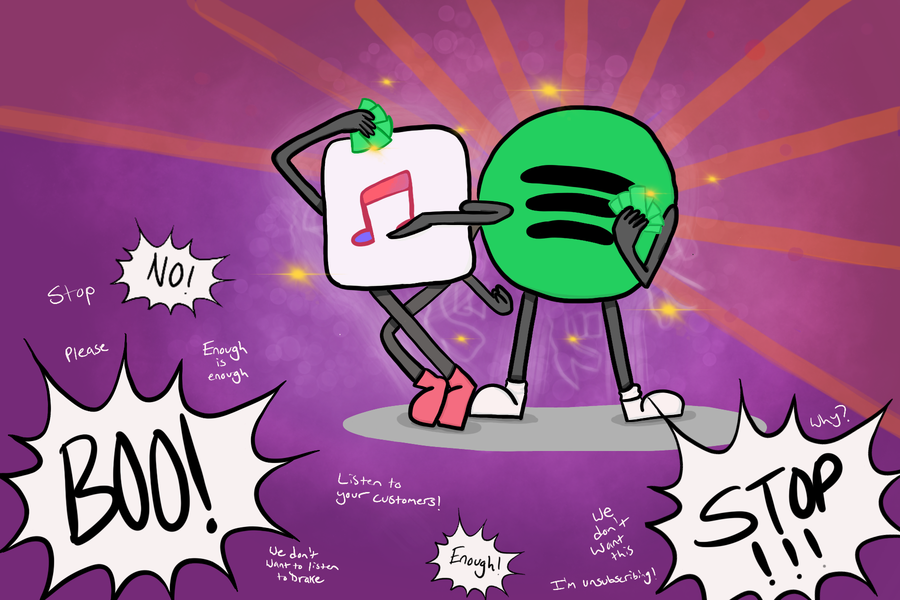Listen to all your favorite songs…But at what cost?
January 25, 2019
“I like that I can download things and listen to them even without internet, so I don’t have to compromise all my data, or if I’m going on a flight or something.”
That sounds great, right? Many music listeners feel the same way that Brooke Derrenberger, a Spotify subscriber, feels about music streaming services.
Services, like Spotify and Apple Music, have taken the world by storm and those who regularly listen to music on the go have every right to enjoy it. Spotify Premium and Apple Music are each $9.99 a month and do not include advertisement breaks. That means subscribers can listen to almost any song they would want to hear.
In comparison, that would be equivalent to buying ten songs each month. Most people listen to way more than that.
Spotify, in particular, targets younger people, too. With a student account, listeners can get a monthly Premium subscription for half the price.
“[People prefer streaming because of] ease of access,” says Dan Lake, a Math and English teacher and music enthusiast. “It’s all well and good to have a CD or a record, but if there’s not a player around, [there’s no point.]”
Even though streaming music is great and easy, this convenience comes at a hidden cost. You are being manipulated into listening to junk.
Albums in the last few years have had a noticeable trend of having more tracks and being longer in general.
A notable example of this trend is the most recent Migos album, Culture II. The tracklist is 24 songs long and spans over the course of an hour and 45 minutes. While long albums are not an inherent issue, most of the songs are just rehashes of the same ideas expressed in their previous album, Culture. DJ Durel, the executive producer of Culture II, said in an interview with Pigeons & Planes that “We’ll do one song in 20 minutes. If they really want to take their time on it, they’ll take 40 or 45 minutes. No more.”
Though great songs can be thrown together quickly, the majority of Culture II is hastily made and full of tracks that were produced for the sole purpose of farming streams and revenue.
How much money can musicians make from streaming services?
Spotify pays artists $0.0044 per stream. This pushes artists away from selling an album as a whole and towards longer albums with more tracks to maximize the revenue made from streaming. This also incentivizes artists to follow trends in the hopes of making hit songs that net them hundreds of millions of streams on services like Spotify and Apple Music that promote such tracks to the front pages.
When artists are pushing out many songs quickly, it’s a problem based on listener frequency– not quality. This is a disservice to the artists’ fanbases.
If you used Spotify in 2018, there is a near 100 percent chance you have at least heard of Drake’s album, Scorpion, the 25-track, hour and a half long monstrosity full of would-be B-sides and uninspired hits.
Regardless of its criticisms, this album was a massive commercial success.
This incident, though, exposed the way Spotify influences its users to market the albums and artists it favors. Drake’s face was plastered across seemingly every official Spotify playlist, regardless of if his songs were featured in those personal playlists. Along with enormous banners across its home page to make very sure that you knew Drake made an album. This annoyed some users so much they got refunds from Spotify due to this promotion because they violated the policy of no advertisement to Spotify Premium users.
Despite this, streaming platforms, such as Spotify and Bandcamp, are not all bad. These services can allow new artists to promote their material to a large group of people and simplify the marketing of music to consumers who already listen to similar sounds.
Bandcamp and Soundcloud are community-driven platforms that are free and easy for independent artist to upload their music, however they still partially adhere to the traditional methods of purchasing individual albums and songs over a monthly subscription.
Larger streaming services such as Apple Music and Spotify have a larger barrier of entry due to the legal responsibility artists have to abide by copyright and tax laws.



